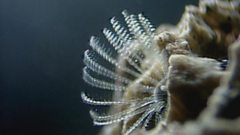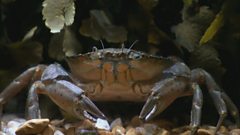
Predator prey relationships in rock pools
Professor Richard Fortey looks at the predatory characteristics of the starfish and the dog whelk and the protective adaptations their prey have developed. The starfish use their sticky tube feet to climb on top of their prey and then by pushing their stomach out through their mouth devour it. Limpets have devised a method to protect themselves from starfish. Small limpets move out of harm's way, but larger ones stand their ground and fight. They lift up their shell and use the edge to stamp down on the starfish鈥檚 tube feet to damage it. The starfish is unable to overcome it and finally gives up. One of the Dog whelk鈥檚 favourite prey is the Mussel. Although mussels are stationary, they have devised ways to protect themselves from marauding dog whelks. Neighbouring mussels will begin to release a sticky secretion and ultimately the Dog whelk becomes trapped and starves to death.
Duration:
This clip is from
More clips from Rock Pool Survivors
-
![]()
Climate change and barnacle distribution
Duration: 03:11
-
![]()
Rock pools by night
Duration: 04:51
-
![]()
Reproductive cycle of crabs
Duration: 07:28
-
![]()
Homely hermit crabs
Duration: 03:41





